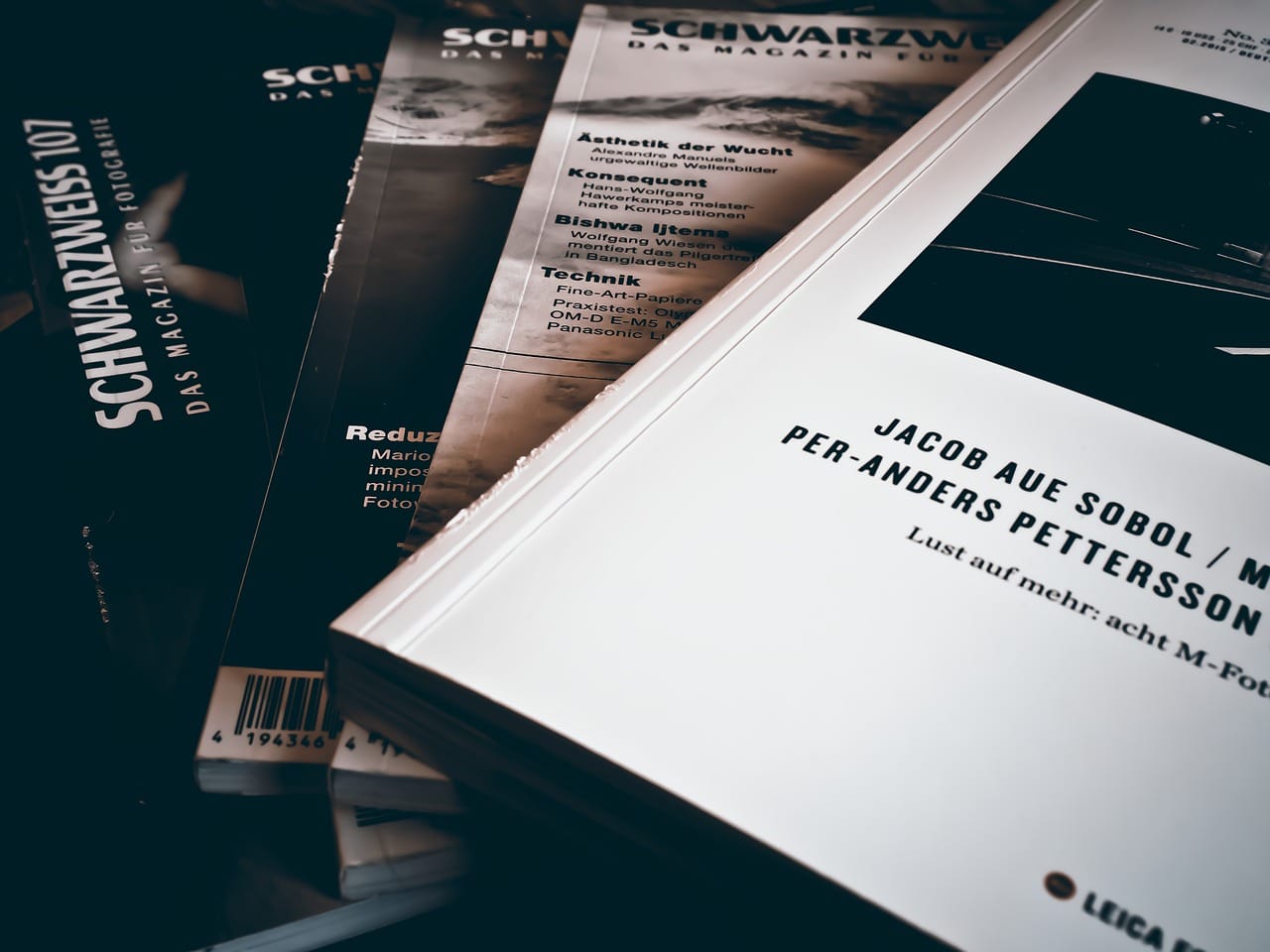Many of us dream of seeing our work in print. It’s a mark of achievement, that says you’ve managed a certain level of quality that others appreciate. It’s also something that you can use as part of your portfolio, not to mention sounding very impressive to your peers.
Getting there, however, is not always easy. If you have always wanted to see your work in magazines but don’t know where to start, or haven’t been successful yet, here are some steps to follow to success.

Image by Michael Gaida from Pixabay
Find Your Target Magazines
To start off with, think about where you would like to be published. It might be that you don’t really mind where it happens so long as you get that first tearsheet (what we call an example of your work on the printed page, or a digital one in modern times). Or it might be that you have harboured dreams of getting into a certain magazine for a long time.
Don’t just stick with one publication. There are a huge amount of photography magazines out there, both online and in print, and they have lots of different styles and focuses. Some of them are more aligned towards the amateur and therefore would be perfect if you are just starting out, while others are angled towards showing off truly impressive professional portfolios.
Don’t limit yourself just to landscape, photography, or travel magazines, either. Think outside the box! Take images of a beautiful model in front of one of your favourite landscapes, and you could find your work in a fashion magazine. Stick a vintage car in the foreground and you could go into an automotive publication. There are endless possibilities out there which will still allow you to shoot the landscapes that you are passionate about.
Discover Their Submission Process
Just as there are lots of magazines out there, there are also lots of editors, and each editor may have a different preferred submission process. The easiest way to find out what this is will normally be just to take a look at their website. You will be able to see a page with all of the submission guidelines, from how to send in your submissions to what format they should be in.
If there is no such page in sight, then take a look at the contact details and simply send them an email to ask. It could be that they are not accepting submissions, in which case you will have to submit your portfolio and wait to hear back (see the next step). Try to contact the picture editor if you can, but if specific email addresses are not listed, you can just go for their normal contact address.
Make sure to also take a careful look at the publication itself before you submit, especially if you are not already familiar with it. What kind of photographs do they publish? Are yours similar enough to make the cut? Are they high enough quality? Some magazines will prefer glossy, sharp images that depict a place perfectly, while others will be more accepting of artsy blur and the use of different techniques.
Try Alternatives to Submission
If the magazine is not taking submissions, we hinted above that you should send in your portfolio. Here’s more explanation on that: gather together a small selection of your very best images, especially images that are in the same style that the magazine already publishes, and get the email of their picture editor.
Send them a cover letter along with this portfolio explaining who you are and what experience you already have, and what you are hoping for from them. Usually you can let them know that you are available for travel commissions, for example. This will put you into their list of photographers that they might contact for assignments – if they like your work enough.
Competition for these positions is high, and an editor might choose to stick with a photographer that they already work with instead of looking further afield. But it’s better to try this tactic than do nothing at all. Send them an update, perhaps once a year, with a new version of your portfolio to remind them that you still exist.
Find Submission Portals
Another great way to find a place to submit to magazines if you aren’t already sure where to go is through portals. Portals are places where lots of different publications will list their submission requirements and give you the chance to send things in. Submittable is one of these – it is more widely used for written work, but can also provide a platform for image submissions as well. Kavyar is another, mostly with a fashion focus but also open to portfolio submissions and other types of photography.
When you find a portal, you should check through the magazine details carefully just like normal. Take the time to actually read one of their issues and check that it is right for you. Read all of their requirements as well, such as whether they only take unpublished work (likely) and how your work will be used.
Follow Their Guidelines
It might sound like it goes without saying, but you would be surprised at how many people skip this step. The reason that magazines have guidelines is not always to provide the best results – so you might be thinking that you can submit a file size larger than they have specified, for example, because your images are so great. Actually, the reason behind the guidelines can commonly be simply to make sure that you are paying attention and doing what you are told.
Think about it – no one wants to deal with a customer or client who will cause trouble. And a magazine editor will not want to publish your images if you show yourself to be incapable of following simple instructions. It makes them nervous of other problems down the road, such as it turning out that you don’t have copyright permission to publish the images or that you kick up a fuss about getting a free copy. Spoiler alert: you are almost never going to be allowed a free copy of a magazine just because you have been published in it. Printing, and digital hosting, is expensive.
Make sure that you go through all of the instructions, follow them step by step, and then check it all over one last time before you hit send to be sure. You don’t want to be that person whose submission is discarded before reading because you didn’t use the right email subject line.
Wait and Repeat
Don’t just send out one set of images to one magazine and then cross your fingers. You are likely in for a bit of a wait no matter what, so don’t sit and refresh your emails every five minutes waiting for a reply – be proactive. Go and find new magazines to approach and submit work to.
Since most publications will only want to see exclusives, i.e. shots that have never been published elsewhere, you will likely run out of things to submit. This is your signal that it is time to go out and shoot some more! You can plan your excursions with specific magazines in mind. For example, if you know that a magazine has a special on mountains coming up, you can get yourself over to a mountain range and start trying to capture something that will fit.
Of course, if those images don’t get picked up by the magazine you were thinking of, you can submit them elsewhere instead. Every shot you take, so long as you put in a good amount of thought as well as technical skill, could end up being published once you get on a roll.
Gather Your Tears
The most important thing to do after you have been successfully published in a magazine is to gather your tearsheets. These can literally just be screenshots of an online magazine viewer! You can also get the printed editions and scan them in to your computer.
Once you have your tears, put them to good use by including them in your portfolio. You can almost guarantee that your work rate will increase when you have tearsheets to show off. Clients want to go with someone who is experienced and high-quality, but the majority of those who are booking photographers really don’t have any idea about what makes a good photograph. How do they judge it? Well, you’ve been published, so you must be good!
This obviously isn’t true in every case, but you will be pleased to see how much more attention you get as a published photographer. Not to mention the fact that when it comes time for a magazine to commission a bespoke photo essay, they will have your name in mind – and this can end up paying very nicely, as well as giving you great new opportunities.
Use these steps to get published – give it a go! So long as you do everything correctly and submit great shots, success should not be far away.










